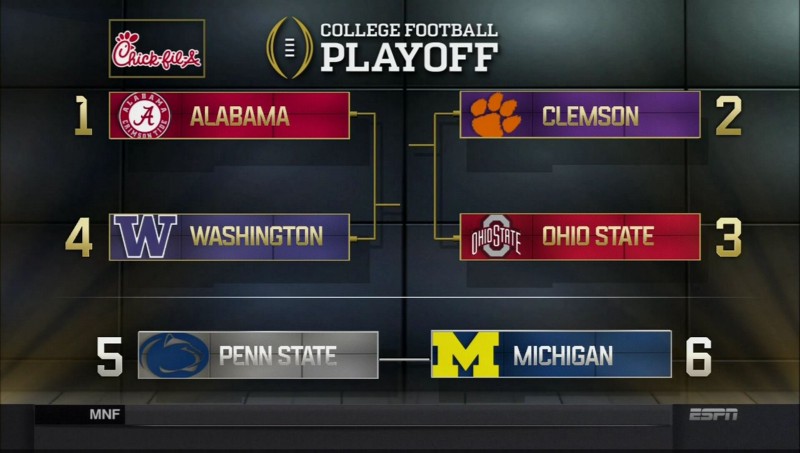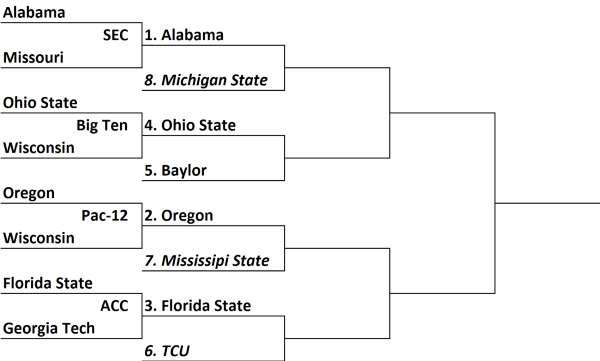The new playoff system not only generates more revenue, it provides fans and teams with the ideology that they have the chance to make it to the national title, without being the best team in the country.

From 1998–2013, the college football community experienced one of the most confusing and frustrating ways to decide which teams would play in the title game.
“In its final years, criticism of the BCS was widespread. Academics, the media, members of Congress, and college football fans alike tended to assert the same grievance that the BCS systematically favored traditional powerhouses at the expense of college football’s less prominent institutions.” -Brandon Miller
Creation of a playoff system intrigued many college football fans, during the BCS era. The idea of seeing the nation’s top teams placed in a bracket gave fans the similar feel that college basketball’s March Madness brings. The money is there as well.
In fact, the monetary value of the new four-team CFP is in excess of $600 million per year. This money is split in two; 70% evenly distributed to the “power-5” conferences, and 30% to the rest of FBS
The new playoff system not only generates more revenue, it provides fans and teams with the ideology that they have the chance to make it to the national title, without being the best team in the country. Think about it; this is the same thought process that so many gravitate towards during March Madness. However, since the CFP has begun, now the arguments are focused on how many teams should be in the playoff. The “ideal” number, according to those in favor of expansion, is an eight-team playoff.
So far there have been three seasons under the CFP, with three different National Champions: Ohio State (2014), Alabama (2015), and Clemson (2016). Arguments are now stirred up for a few reasons. First, there has already been controversy over why Penn State did not make the playoff in 2016.

The arguments are never ending. There were three teams, potentially four that could have been in the mix for the third and fourth spots in the playoff. Michigan, Washington, Ohio State, and Penn State. As the final committee rankings came in the Sunday following Championship Weekend, a team many had written off as a candidate found themselves in the top-4. Ohio State not only made the playoff, they landed third in the rankings, keeping out a Penn State team that beat the Buckeyes in the regular season, as well as won the Big 10 title.
One of the pros for the CFP is supposed to be the known criteria for selection. The criteria can be found, plain as day, on the CFP’s official website. However, the committee appears to have gone away from their original criteria, making an exception to some of the rules to include Ohio State last season. While this outraged many fans across the country, it’s important to remember why the CFP was really created.
One of the BCS’s biggest criticisms was the lack of human-factor in regard to the “eye test”. Fans wanted the system to take into account the actual play of teams on the field; things that may not be involved in the statistics or overall record. While tons of college football fans didn’t want to see Ohio State in the playoff, their final regular season game against Michigan was most likely what pushed the committee in their favor.
As far as the criteria is concerned, it is important to remember the committee’s job. They are not picking the four most deserving teams; they’re picking the best four teams in the country. The criteria is in place as a guideline for the members to go through as they attempt to select the top-4 teams in the country.
Just like we had the outcry for a playoff system, the new “need” from college football fans is an expanded playoff. Some feel that four teams isn’t large enough, and doesn’t truly allow for inclusion of non-power 5 teams. Going on that theory, let’s look at how an 8-team playoff would have looked the last three seasons:
2014 CFP
1. Alabama vs. 8. Boise State
2. Oregon vs. 7. Mississippi State
3. Florida State vs. 6. TCU
4. Ohio State vs. 5. Baylor
2015 CFP
1. Clemson vs. 8. Houston
2. Alabama vs. 7. Ohio State
3. Michigan State vs. 6. Stanford
4. Oklahoma vs. 5. Iowa
2016 CFP
1. Alabama vs. 8. Western Michigan
2. Clemson vs. 7. Oklahoma
3. Ohio State vs. 6. Michigan
4. Washington vs. 5. Penn State
Imagine getting the rematch of Michigan vs. Ohio State, in a neutral site, with a playoff atmosphere; that’s what college football fans live for. Or think back to 2015, Christian McCaffrey’s Sanford squad faces off with an overrated, and underachieving Michigan State, leading to them playing the winner of Alabama and Ohio State.
What we’re looking at is a potential for more exciting games, where teams at the top of the rankings, face off. Think about it, which games do you look forward to each week? Wherever College Gameday is, is usually at the top of my list each week. Both teams are normally ranked in the top-25 and the match up has some sort of major implications attached to it.
Needless to say, these would be fascinating matchups to watch in a post season playoff, however, it seems that expansion would take a lot more change than supporters realize.

First, the expansion would affect the overall scheduling of the regular season. Team’s already play anywhere from 12–15 games each season, a span from August to January.
The issue with expanding the playoff really comes down to conference championships.
While I’m sure the Big 12 would love an expansion in place of a conference championship, there are many instances when we need the championship game to decide who the top team in the conference is.
The counter argument to this is would be, considering what happened to Penn State and Ohio State this past season. Penn State won their conference title, as well as beat Ohio State, however, they were kept out of the playoff.
The money that conference championships brings in would also be a big issue brought into question. There are long-term deals like the ACC and Dr. Pepper that benefit both the ACC as a conference and the teams playing in the championship. These are funds that conferences are not going to want to give up for a percentage of all revenue brought in like the CFP calls for now.
Second, expansion would not fix the problem of inclusion, it would cause more debate. Just like the playoff debate, an eight-team playoff would essentially lead to the same fans screaming that the 9th ranked team should really be the 8th ranked. Essentially, we’re talking about the same argument that goes on for teams ranked 4th and 5th right now in the CFP system.
No matter which side of the fence you sit on, the idea of expansion is exciting to talk about and debate. Personally, the idea of adding another game or two to the college football slate makes me thrilled; logistically it may be a long-shot, but that doesn’t take away from the excitement that comes from the possibilities.
What do you think?
With that being said, we want to know what you think about the CFP expanding from four to eight teams:
Do you believe the playoff should expand? If so, how should it work logistically scheduling wise?
Should the criteria be tweaked to represent exactly what the committee is looking for?
Overall are you as a sports fan satisfied with the playoff system?
Tweet us your opinions on the CFP expanding, or send any thoughts on the matter.
Front Office Sports is a leading multi-platform publication and industry resource that covers the intersection of business and sports.
Want to learn more, or have a story featured about you or your organization? Contact us today.

















